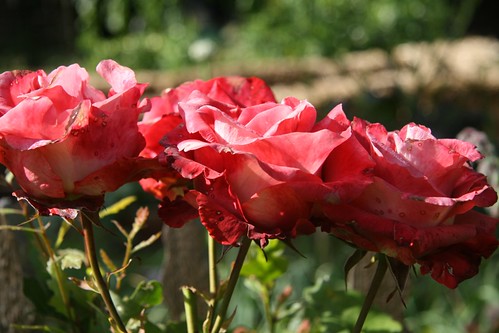
As I mentioned a few days ago, I’m not the kind of flower gardener that is over nurturing. If they need more water than I’m willing to give them, out they go. If they get mildew or rust, I don’t bother tending to them, I pull them out. I save my nurturing for the children and pets, the flowers need to be independent and strong by themselves. I do love a good perennial that can take a period of drought, a ball thrown in the middle of it and yes, a big fat cat sitting on top of it and still keep growing and flowering. Yet these two roses are too well established in our garden to just rip them out, so maybe, just maybe I might help them out. Only I don’t know what to do. Can you help me?
Just what are those spots on the petals of the roses above? Only this rose bush has it, and only on the petals, not the leaves. The rose bush next to it doesn’t have a spot at all. Have you seen this before? What is it and how do you treat it?
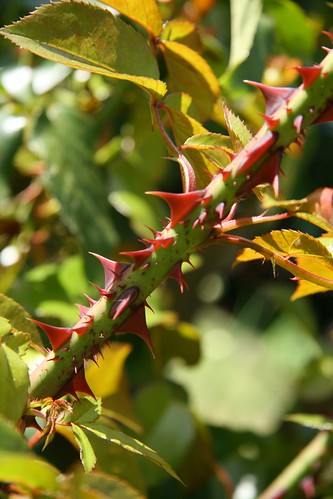
And while the rose bush next to it doesn’t have spots on the petals, it does have these wild new stalks growing up out of the base that are covered in an insane amount of thorns. The rest of the stalks have your normal amount of rose thorns but three new shoots look like some sort of primitive torture device. Should I cut them off? And if so, do you know of a good brand of metal gloves that I can wear while doing it? Should I leave them? Has this ever happened to your roses?
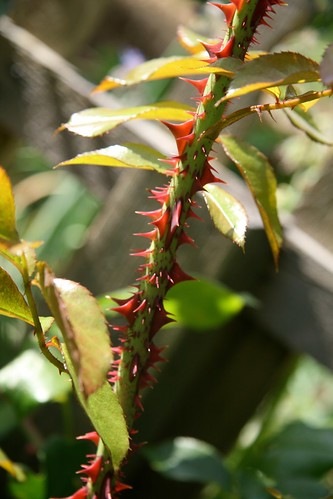
And well, then there is this big fat cat who sits on three plants at once…. Well I might just keep him around, the plants shall have to deal with it!
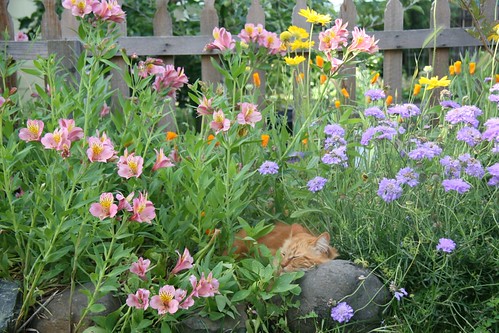


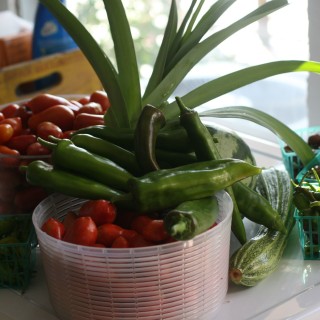

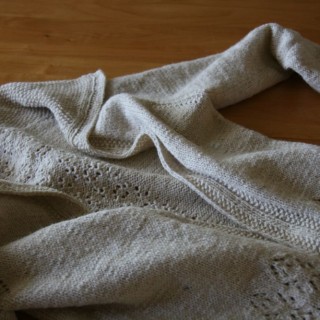



the shoot that is coming up out of the root should just be cut out. Roses are almost always grafted onto wild root stock which tends to bolt under stress. Just hack the high thorn because it will pull the gifts of the root stock away from the grafted pretty roses.
The other stuff is probably “rust” which comes out of a high water/mildew thing. Sulfur helps but there are some very organically decent sprays you can put on the roses to fight the mildew. On the other hand, I just take the spots sometimes. Roses also like to be fed a bit. Your local garden store should be able to help.
the cat is adorable. Can’t help you there.
Also, cut the roses after blooming and that will keep the blooms coming. You have mad gardening skills which basically transfer over reasonably decent on the roses. Come the Fall, stop cutting the flowers and let the roses go dormant. Then, by Washington’s birthday, take a hard look at the rose bush, cut back the dead stock and the week branches. Look for the bud marks and cut just above them. Feed the rose, give it some sulfur for the rust from time to time and the roses will give you many many flowers and buds for your dinner table in gratitude.
Google roses for more coherant, detailed instruction. Love your blog. Lurking from Santa Rosa.
I know nothing about roses – BUT that is the best picture of Beau! Too darn cute
The thorny “shoots” coming from the base are called “suckers” and they are growing from the root stalk. They should be trimmed off at the base as soon as you see them. You will probably get them seasonally on a cyclic basis.
I’ll keep my eyes peeled for a diagnosis to the disease. I have no clue what it is off the top of my head. Good luck with it and get those suckers trimmed. It will reduce stress on the plant and help it fight the other problem.
I agree with Jo. Those ‘shoots’ are suckers which grow out of, or below, the graft. Cut them off asap. They look pretty young and green so should be no problem to cut with a pair of secateurs, as close to where they are emerging as possible (without damaging the main plant).
As to the spots – I can’t enlarge the photo enough to quite see the details but some more information would be good. Are the spots in the bud as well? Before the blooms open? Are they spots or little lumps? It looks like only the petals with the spots look a little ‘burnt’ on the edges?
CAnnot quite tell form photo, but I know my roses are suffering form all teh wet….
definitely prune out the suckers..they will not bloom as the same variety, they are comign from the more primitive rootstock and are taking energy from your plant. In general, make sure your rose has good air circulation, meaning pull surrounding plants back if they have grown up into the rose bush and take a few branches out of the inside of the shrub to promote good airflow. Then beef up with plant with epsom salts, alfalfa pellets.
http://scvrs.homestead.com/magicelixirs.html
The extra thorns are for defense against the fat cat!
Ha! Too funny! Thanks for all the responses. I’m going to head out to the garden this morning with the pruners and a big box of bandaids for those suckers. I’ll also try and get a better picture of those spots to show you. Thanks everyone!
if the flower spots are only on the outer petals of the roses, then it’s probably tiny green bugs that are poking holes and sucking on the buds before they open. My roses get them, too. I call them aphids, but that’s probably not the scientific name for them. You can manage them by spraying them off with a strong blast from the hose, or a squirt with some insecticidal soap. Or just smooshing them with your fingers.
If you’re seeing larger-scale brown-ish spots on your flowers, it’s probably from all of the rain we’ve been having. I’ve got them this year (over here in Rohnert Park). Nothing to do but enjoy what you DO have, and deadhead them when you’re done with them to encourage new flowers.
As for rust/powdery mildew on the leaves — i manage it by not overhead watering, thinning inside/crossing branches to improve air circulation, and not worrying about having a handful of affected leaves.
Roses are really quite easy if you don’t ask for perfection of them.
Funny I was just out in the garden taking some photos of spots on my boysenberry leaves to try and figure out what is all over them. I wonder if what you have going on could be spot anthracnose? I came accross it while looking into septoria. I’m just learning about it myself, I’ve never had such an issue before. I think all the rain has made the fungus/bacteria issue more prevelant than usual. At least here in our neck of the woods!
The mildew problem can be helped by putting 1 part milk to 9 parts water into a sprayer and spraying heavily, all the mildewed parts, on top and underneath and for several days if necessary. Always rinse off the leaves during the morning hours so the plant can dry out during the day. (The mildew is not from the water, but from mildew fungus/spores, so rinsing the leaves (and fungus/spores) off every morning can also take care of the problem. But, if you are lazy like me and don’t remember to rinse every morning….then just do the spraying with the milk and water mix.)
LOVE your cats!!! AND…your blog! Thanks so much for it!
Sincerely,
Chris
Oh…one more thing! I’ve heard that goatskin gloves are the best for dealing with rose thorns.